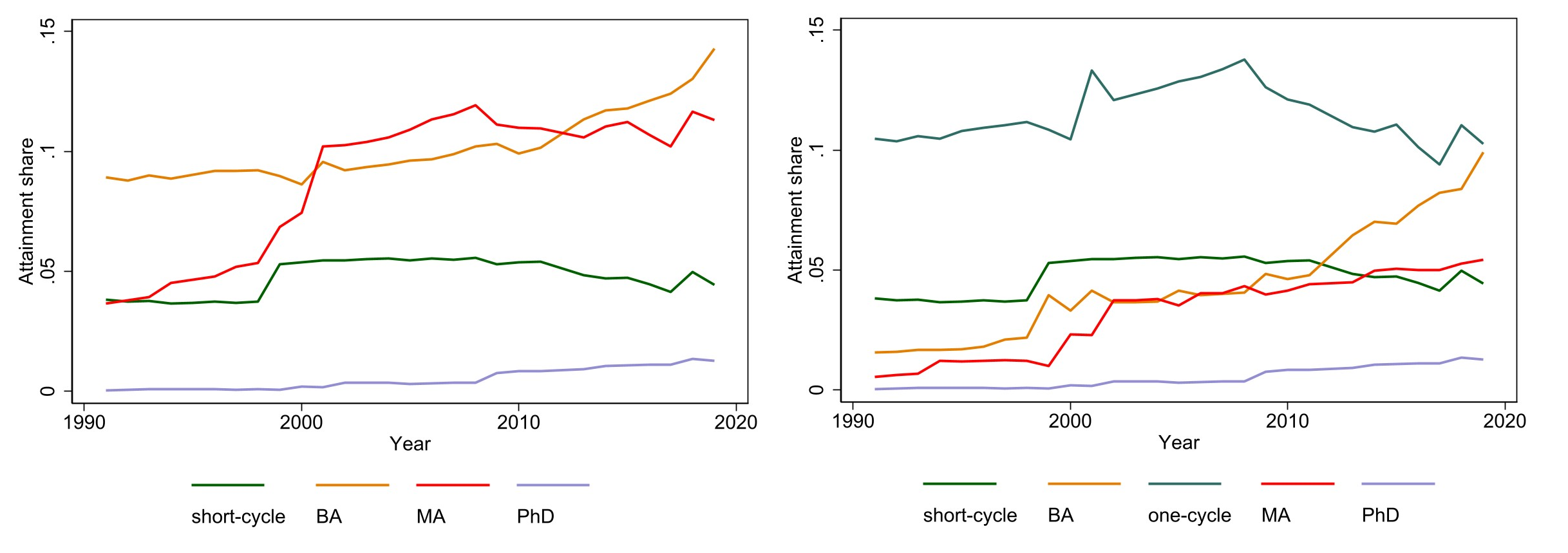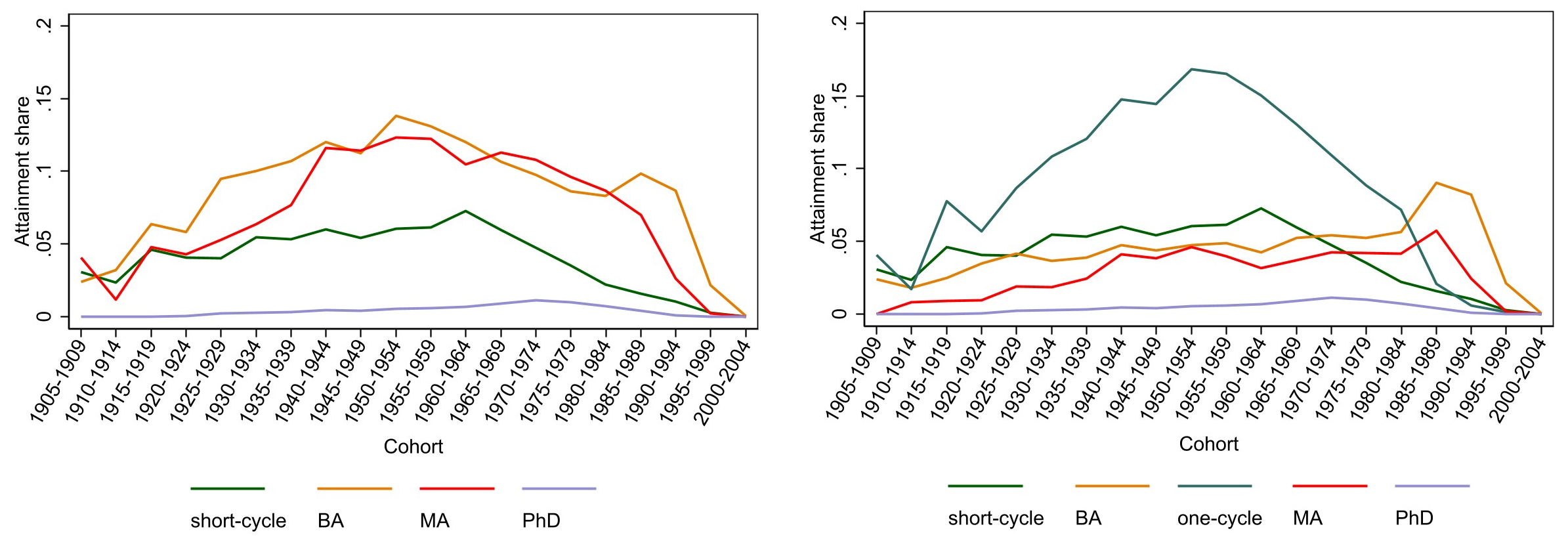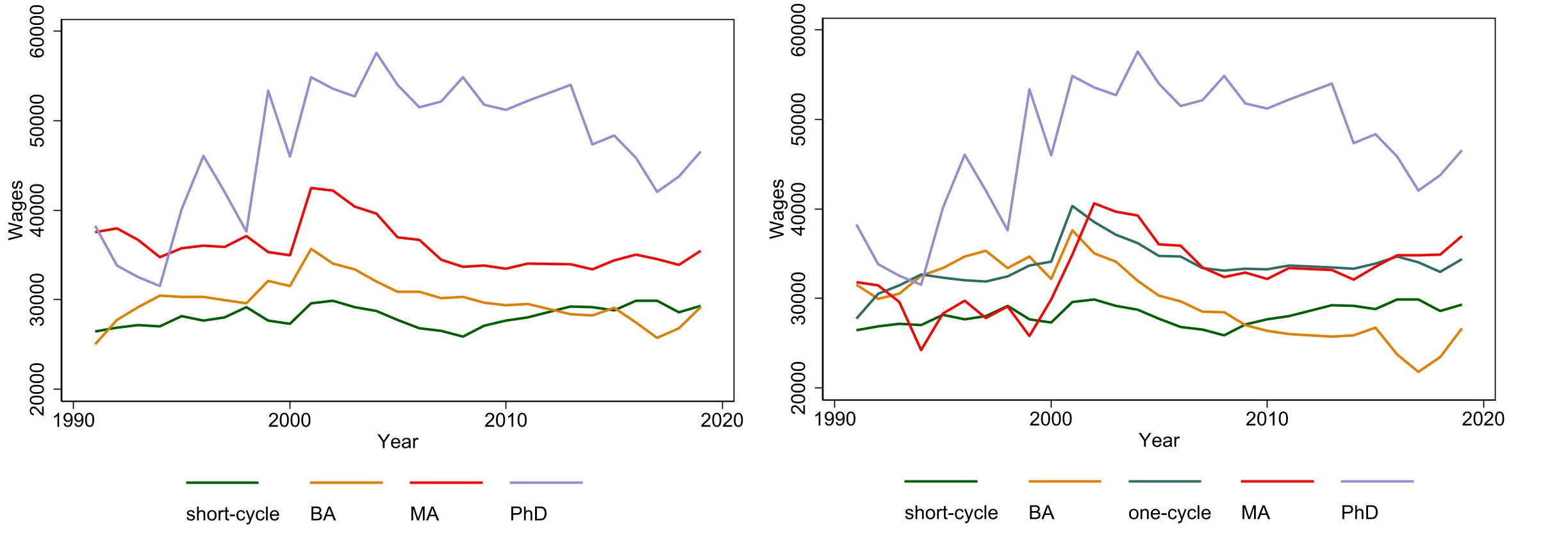Issue, No.25 (March 2023)
Who are the bachelors? – Capturing degree heterogeneity within the tertiary level in comparative perspective
Around the globe, countries face rapid educational expansion since the second half of the 20th century (OECD, 2023). In contrary to educational expansion after World War II, the so-called new millennium higher education expansion, mainly affects the tertiary level (Jungbauer-Gans, 2018; Schofer & Meyer, 2005). The share of higher education graduates has increased steadily between 1995 and 2015 so that in 2015 more than half of the working-age population obtained a tertiary degree in Canada, Ireland, Belgium and the US (Sauer et al., 2022). As a result of these expansion dynamics, heterogeneity within the tertiary level became increasingly relevant to explain societal outcomes such as employment opportunities, income inequality and social mobility (e.g. Pfeffer & Hertel, 2015). Among other things, this plays out through the degree structure.
Since 2019, a variable (educlev) that enables to differentiate between short-cycle tertiary, bachelor (BA), master (MA) and doctoral (PhD) degrees is available within the LIS data for all countries and time periods. This variable is constructed by translating national education levels into internationally comparable categories consistent with 1-digit ISCED11 levels (Schneider, 2013; UNESCO, 2012). As illustrated by Bar-Haim et al. (2019) in an earlier issue of this outlet, the more detailed education measure enables to obtain a more nuanced and potentially more accurate picture about the relation between higher education, corresponding labour market returns, and inequality. In line with the existing literature, they show that in the US, returns to short-cycle and BA degrees are lower than returns to MA and PhD degrees respectively, both in 1991 and in 2016. However, the increase in returns between the two time points is most pronounced for MA and PhD degrees while it does not exist for short-cycle degrees, which are predominantly obtained from community colleges in the US.
The two-cycle study structure in the US which mainly distinguishes between BA and MA degrees has a long tradition, which facilitates analyses of trends over time and across cohorts. In contrast, in some European countries like Germany, almost exclusively one-cycle structures existed until the Bologna process was initiated in 1998/1999 (Bologna, 1999; Sorbonne, 1998). Aiming to create a European Higher Education Area (EHEA), one of the central goals was structural convergence of higher education degrees. As a result, 20 European countries adapted their higher education systems so as to broadly establish two-cycle structures. Yet, the timing as well as the speed of implementation processes varied substantially across countries (Kroher et al., 2021) – Germany, for example, changed gradually over several years.
This poses challenges to comparative analyses as they necessitate harmonization not only across countries but also across birth cohorts within single countries. This raises the question of what it means that, for example, persons born in the 1960s are coded to have obtained BA or MA degrees or equivalent even if those educational certificates did not exist at the time they entered and completed higher education. To put it another way: who are the bachelors in countries having no tradition of two-cycle degrees?
Even if ISCED 2011 provides guidance on how to map one-cycle into two-cycle structures retrospectively, the resulting classification might entail misleading conclusions about expansion dynamics and related labour market outcomes. Therefore, LIS datasets store country-specific education classifications (educ_c) alongside the harmonized variables (educ, educlev). In the following, we illustrate how this information can be used to investigate educational expansion in Germany. We chose Germany as an example, because it is – with respect to the number of enrolled students – the largest European country that changed from one-cycle to two-cycle degree structure (Neugebauer et al., 2016). Traditional certificates like diploma, magister and state examina had a typical length of 4 to 5 years which enabled to enter the graduate labour market or to proceed to doctoral studies.
The left panel of Figure 1 depicts time trends of tertiary educational attainment broken down by the detailed harmonized measure available in LIS data since 2019. The right panel shows trends based on a categorization we constructed by using country-specific education levels to distinguish `traditional’ one-cycle degrees from the `new’ two-cycle degrees. In Germany, the Bologna process was implemented in the period 2000 – 2004/05 (Kroher et al., 2021); below 50% of institutions had adopted two cycles in 2003, 50%-70% in 2007 and 85%-100% in 2010 (Diego & Sabic, 2015). Moreover, Germany is among the countries with the largest number of exemptions regarding field of study: medicine, dentistry, veterinary studies, pharmacy, law, theology and, in some states also teacher education remain excluded from the two-cycle structure (Diego & Sabic, 2015). Thus, with 10% of the population attaining a diploma certificate, one-cycle degrees remain the major category in 2019. However, while the attainment share was slightly increasing after unification, it has been declining steadily since 2009. At the same time, the share of graduates with a BA degree was constantly rising. This is also true, yet less pronounced, for the evolution of MA certificates.
Consequently, applying international standards defined by ISCED 2011 to harmonize national certificates for older birth cohorts, one-cycle degrees obtained from universities are mapped into MA degrees, and one-cycle degrees obtained from universities of applied sciences (`Fachhochschule’) are mapped into BA degrees. Thus, the MA attainment share depicted in the left panel hides both the shrinking relevance of one-cycle degrees as well as the increasing relevance of MA degrees, and, even more importantly, the actual attainment share of BA degrees is substantially overestimated. PhD and short-cycle tertiary degrees are categorized equally and show overlapping trends. The share of PhDs is marginally increasing. Short-cycle tertiary degrees which include certificates from technical schools (`Fachschule/Meister’) were relatively stable but decrease slightly since 2009.
Looking at trends across birth-cohorts enables to obtain deeper insights into the transition from one- to two-cycles in Germany (see Figure 2). The cohort structure is obtained by pooling all available surveys (1991-2019, unbalanced). This has the additional advantage of larger sample sizes for each educational level. Before the broader implementation of the Bologna process, BA and MA degrees could be obtained from selected institutions and/or in particular, internationally oriented fields of study such as business administration. Therefore, a relatively stable share of around 5% among cohorts born between the 1940s and the 1970s obtained BA or MA certificates, with the latter share being slightly smaller. Diploma degrees are the major category for all but the most recent birth cohorts. For cohorts born after 1989, BA and MA degrees replace one-cycle certificates. Some of those recent BA graduates might still proceed to the MA level. The drop for cohorts born after 1995 is due to them being too young to have entered tertiary education. It is important to note that the harmonized measure would suggest a drop in MA and BA certificates already for cohorts born after 1959 which is in fact solely due to the implementation of the two-cycle structure.
Figure 1: Higher educational attainment in Germany (by year)

Figure 2: Higher educational attainment in Germany (by birth cohort)

Figure 3: Annual wages by higher education level in Germany

For purposes of illustration, Figure 3 shows annual wages by harmonized LIS (left panel) and adapted (right panel) education level. Since there are no classification discrepancies, the time patterns of wage returns to PhD and short-cycle degrees over time resemble each other. As expected, MA and one-cycle degrees have similar monetary returns. However, we observe higher wage returns for BA graduates using the harmonized variable than revealed by accounting for differences in one-cycle certificates and BA degrees. It has to be noted that the latter time series might be biased downwards since we observe `new’ post-Bologna BAs at an early stage of their occupational career when wages can be low as compared to `old’ pre-Bologna BAs which are also observed at higher levels of seniority. More research is needed to disentangle age, period and cohort effects.
Wrapping up this contribution, we would like to provide some general conclusions. We had asked who are the bachelors?’. Our analyses have shown that harmonizing educational categories according to international standards may hide country-specific peculiarities and meaningful policy changes such as the Bologna process in Europe. In our example, Germany, some of the bachelors are actually graduates from one-cycle degrees from applied higher education institutions. This could result in an inaccurate picture of expansion dynamics and of how increasing educational attainment affected labour market returns in some countries. These challenges notwithstanding, international comparisons are of great value for researching educational returns and inequality. To deal with potential pitfalls arising from differences in national education degrees, LIS data provides both harmonized and country-specific variables so that researchers can check classifications, validate the interpretation of their results or create their own categorization in alignment to the specific research purpose and question.
In conjunction with this newsletter, we provide a compilation of the timing of implementing a two-cycle degree structure in countries available in LIS data. Information provided are based on Kroher et al., (2021) and Diogo & Sabic, (2015). The dataset can be found here.
References
| Bar-Haim, E., Hartung, A., & Neugschwender, J. (2019). Extending educational attainment variables at LIS: On the importance of analyzing returns to education based on detailed education categories and years of education. Issue, No.9 (March 2019). |
| Bologna Declaration (1999). The Bologna Declaration of 19 June: Joint Declaration of the European Ministers of Education. |
| Diogo, S., & Sabic, N. (2015). Implementation of the Bologna Degree Structure in the European Higher Education Area. Technical Report. ACUP – Catalan Association of Public Universities. |
| Jungbauer-Gans, M. (19.09.2018). Determinants and effects of higher education expansion in the 21st century. 1st Forum Higher Education and the Labour Market (HELM), Nürnberg. |
| Kroher, M.; Leuze, K.; Thomsen, S.L., & Trunzer, J. (2021). Did the “Bologna Process” Achieve its Goals? : 20 Years of Empirical Evidence on Student Enrolment, Study Success and Labour Market Outcomes. Hannover: Institutionelles Repositorium der Leibniz Universität Hannover, 2021 (LCSS Working Papers ; 10), 38 S. DOI: https://doi.org/10.15488/11370. |
| Neugebauer, M., Neumeyer, S., & Alesi, B. (2016). More Diversion than Inclusion. Social Stratification in the Bologna System. Research in Social Stratification and Social Mobility, 45, 51-62. |
| OECD (2023). https://data.oecd.org/eduatt/population-with-tertiary-education.htm. |
| Pfeffer, F., & Hertel, F. (2015). How Has Educational Expansion Shaped Social Mobility Trends in the United States? Social Forces, 94(1): 143–180. doi:10.1093/sf/sov045. |
| Sauer, P., Van Kerm, P., & Checchi, D. (2022). Higher Education Expansion & Labour Income Inequality in High-income Countries: A Gender-specific Perspective. LIS working papers series – No. 837. |
| Schneider, S. L. (2013). The International Standard Classification of Education 2011, in Gunn Elisabeth Birkelund (ed.), Class and Stratification Analysis (Comparative Social Research, Volume 30) Emerald Group Publishing, 365 – 379. |
| Schofer, E., & Meyer, J. W. (2005). The worldwide expansion of higher education in the twentieth century. American Sociological Review, 70(6), 898-920. |
| Sorbonne Declaration (1998). Sorbonne Joint Declaration: Joint declaration on harmonization of the architecture of the European higher education system. |
| UNESCO Institute for Statistics. (2012). International standard classification of education: ISCED 2011. Montreal: UNESCO Institute for Statistics. |
